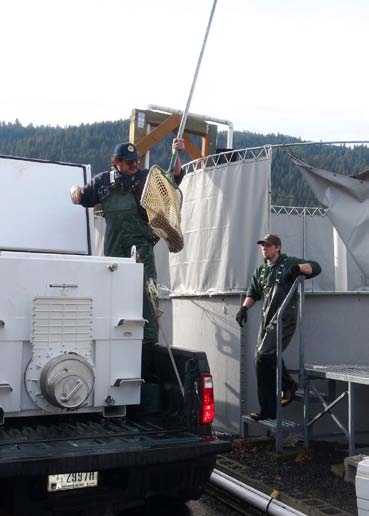forum
library
tutorial
contact

Reconditioning Steelhead Kelts
Improves Their Survival
by Laura Berg
NW Fishletter, September 6, 2016
|
the film forum library tutorial contact |

|
Reconditioning Steelhead Kelts
by Laura Berg
|
Held in a hatchery setting for about six months, they were fed a special diet and treated for diseases and parasites.
This group (which exhibit highest return rate) was then released to the stream from which they were originally captured.
 Steelhead, unlike salmon, can spawn multiple times during their lifetimes; and a strategy to encourage repeat spawning by wild steelhead in the Yakima River is working, according to a new study.
Steelhead, unlike salmon, can spawn multiple times during their lifetimes; and a strategy to encourage repeat spawning by wild steelhead in the Yakima River is working, according to a new study.
The Yakama Nation's "reconditioning" program at its Prosser hatchery treats or reconditions steelhead after they spawn to rejuvenate them before they are released to spawn again. The program is discussed in "Evaluating Steelhead Kelt Treatments to Increase Spawners in the Yakima River Basin," published July 15 in the North American Journal of Fisheries Management.
One factor believed to be limiting survival of Columbia River kelts, as the post-spawning steelhead are called, is poor migration success past the river's multiple dams.
The research shows reconditioning improves the chances--from 3 percent to about 15 percent--that steelhead will survive to attempt spawning again.
Ninety-five percent of the steelhead collected in the research were female.
All steelhead populations in the Columbia River Basin are listed as threatened or endangered under the Endangered Species Act.
The research, jointly conducted by the Yakama Nation and Columbia River Inter-Tribal Fish Commission (CRITFC), is supported by BPA as part of its obligation to mitigate and enhance the Columbia Basin fish resources affected by the development and operation of hydroelectric facilities.
The study evaluated three treatments for kelts captured in the Yakima River Basin. The three treated groups were compared with a control.
One group was transported and released below Bonneville Dam to give the fish unobstructed access to the ocean.
Another group received short-term reconditioning; they were held and fed in a hatchery then transported below Bonneville.
The third group received long-term reconditioning. Held in a hatchery setting for about six months, they were fed a special diet and treated for diseases and parasites. This group was then released to the stream from which they were originally captured, "concurrent with the peak return of the pre-spawn steelhead, and migrated upstream toward spawning areas without returning to the ocean," the journal article says.
When the three treatments were compared with the in-river migration control group, the long-term reconditioning treatment exhibited the highest return of repeat spawners, a range of 11.5-17.6 percent, the study says.
The short-term reconditioning treatment had a 3.2-percent return rate. The transport-only treatment had a 0.9-percent return rate, which was lower than the control group's return rate of 2.7 percent.
"The results indicate that long-term steelhead kelt reconditioning is more successful than either transportation or in-river migration alternatives at increasing potential repeat spawner abundance," the researchers said.
Based on the Yakama Nation's past successes with Yakima River reconditioning, other tribes, PUDs and state and federal fish agencies are collaborating on similar kelt reconditioning efforts elsewhere in the Columbia Basin.
Douglas County PUD and the U.S. Fish and Wildlife Service constructed an isolation building at the Winthrop National Fish Hatchery in Winthrop, Wash., for kelt reconditioning.
Not accessible to the public, the facility will reduce fish stress by keeping the surroundings quiet during the steelheads' reconditioning period. These kelts are returned to the Methow River near Pateros, Wash. The program's goal is to increase the number of wild spawners in the Methow Basin by 10 percent.
The Yakama Nation and CRITFC are coordinating with the Chelan County PUD, Douglas and Grant PUDs and others to capture and recondition steelhead in other upper Columbia River tributaries.
CRITFC and the Nez Perce Tribe are studying kelt reconditioning and reproductive success in the Snake River Basin.
The tribes and CRITFC are also using genetic testing at their Hagerman Laboratory in Idaho to identify which tributaries in the Snake and Yakima basins are producing the most kelts.
As the published results of this latest research suggest, these concurrent programs hold the potential to contribute hundreds of repeat spawners a year to the many river systems in the Columbia and Snake basins [Laura Berg].
learn more on topics covered in the film
see the video
read the script
learn the songs
discussion forum
